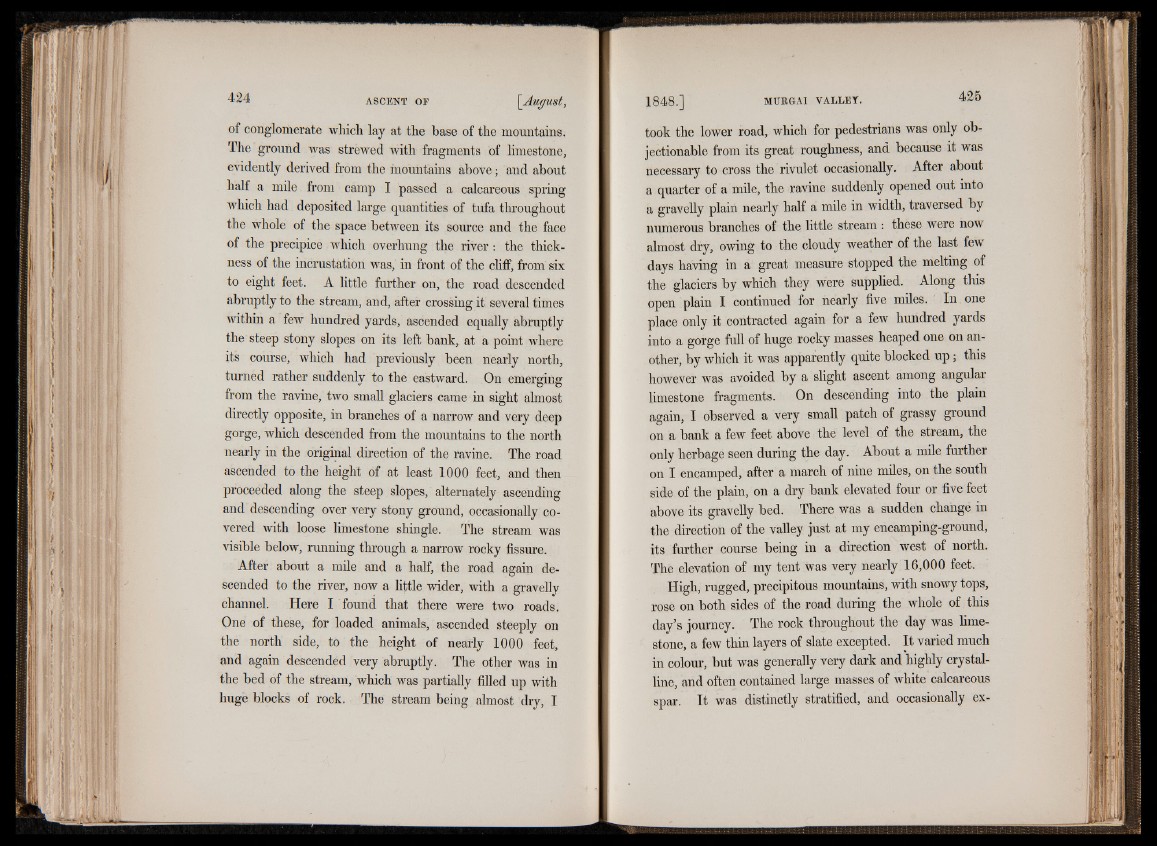
of conglomerate which lay at the base of the mountains.
The ground was strewed with fragments of limestone,
evidently derived from the mountains above; and about
half a mile from camp I passed a calcareous spring
which had deposited large quantities of tufa throughout
the whole of the space between its source and the face
of the precipice which overhung the river: the thickness
of the incrustation was, in front of the cliff, from six
to eight feet. A little further on, the road descended
abruptly to the stream, and, after crossing it several times
within a few hundred yards, ascended equally abruptly
the steep stony slopes on its left bank, at a point where
its course, which had previously been nearly north,
turned rather suddenly to the eastward. On emerging
from the ravine, two small glaciers came in sight almost
directly opposite, in branches of a narrow and very deep
gorge, which descended from the mountains to the north
nearly in the original direction of the ravine. The road
ascended to the height of at least 1000 feet, and then
proceeded along the steep slopes, alternately ascending
and descending over very stony ground, occasionally covered
with loose limestone shingle. The stream was
visible below, running through a narrow rocky fissure.
After about a mile and a half, the road again descended
to the river, now a little wider, with a gravelly
channel. Here I found that there were two roads.
One of these, for loaded animals, ascended steeply on
the north side, to the height of nearly 1000 feet,
and again descended very abruptly. The other was in
the bed of the stream, which was partially filled up with
huge blocks of rock. The stream being almost dry, I
took the lower road, which for pedestrians was only objectionable
from its great roughness, and because it was
necessary to cross the rivulet occasionally. After about
a quarter of a mile, the ravine suddenly opened out into
a gravelly plain nearly half a mile in width, traversed by
numerous branches of the little stream : these were now
almost dry, owing to the cloudy weather of the last few
days having in a great measure stopped the melting of
the glaciers by which they were supplied. Along this
open plain I continued for nearly five miles. In one
place only it contracted again for a few hundred yards
into a gorge full of huge rocky masses heaped one on another,
by which it was apparently quite blocked u p ; this
however was avoided by a slight ascent among angular
limestone fragments. On descending into the plain
again, I observed a very small patch of grassy ground
on a bank a few feet above the level of the stream, the
only herbage seen during the day. About a mile further
on I encamped, after a march of nine miles, on the south
side of the plain, on a dry bank elevated four or five feet
above its gravelly bed. There was a sudden change in
the direction of the valley just at my encamping-ground,
its further course being in a direction west of north.
The elevation of my tent was very nearly 16,000 feet.
High, rugged, precipitous mountains, with snowy tops,
rose on both sides of the road during the whole of this
day’s journey. The rock throughout the day was limestone,
a few thin layers of slate excepted. It varied much
in colour, but was generally very dark and highly crystalline,
and often contained large masses of white calcareous
spar. It was distinctly stratified, and occasionally ex